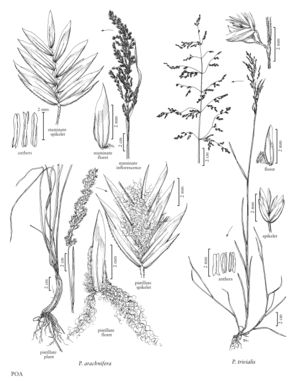Difference between revisions of "Poa trivialis"
FNA>Volume Importer |
FNA>Volume Importer |
||
| Line 17: | Line 17: | ||
-->{{Treatment/Body | -->{{Treatment/Body | ||
|distribution=Conn.;N.J.;N.Y.;Wash.;Del.;D.C;Wis.;W.Va.;Mass.;Maine;N.H.;R.I.;Vt.;Wyo.;B.C.;Greenland;N.B.;Nfld. And Labr. (Labr.);N.S.;Ont.;P.E.I.;Que.;Sask.;Yukon;N.Mex.;Tex.;La.;N.C.;Nebr.;Tenn.;Pa.;Calif.;Nev.;Va.;Colo.;Md.;Alaska;Ala.;Ill.;Ga.;Ind.;Iowa;Idaho;Mont.;Oreg.;Ohio;Utah;Mo.;Minn.;Mich.;Kans.;Ky.;S.Dak. | |distribution=Conn.;N.J.;N.Y.;Wash.;Del.;D.C;Wis.;W.Va.;Mass.;Maine;N.H.;R.I.;Vt.;Wyo.;B.C.;Greenland;N.B.;Nfld. And Labr. (Labr.);N.S.;Ont.;P.E.I.;Que.;Sask.;Yukon;N.Mex.;Tex.;La.;N.C.;Nebr.;Tenn.;Pa.;Calif.;Nev.;Va.;Colo.;Md.;Alaska;Ala.;Ill.;Ga.;Ind.;Iowa;Idaho;Mont.;Oreg.;Ohio;Utah;Mo.;Minn.;Mich.;Kans.;Ky.;S.Dak. | ||
| − | |discussion=<p>Poa trivialis is an introduced European species. Only Poa trivialis subsp. trivialis is present in the Flora region. Several cultivars have been planted for pastures and lawns, and have often escaped cultivation. Poa trivialis sometimes grows with P. paludigena (p. 572), but has distinctly longer ligules and anthers. It is easily recognized by its flat blades, long ligules, sickle-shaped lower glumes, prominent callus webs, and lemmas with pubescent keels and pronounced lateral veins.</p> | + | |discussion=<p><i>Poa trivialis</i> is an introduced European species. Only <i>Poa trivialis</i> subsp. trivialis is present in the Flora region. Several cultivars have been planted for pastures and lawns, and have often escaped cultivation. <i>Poa trivialis</i> sometimes grows with <i>P. paludigena</i> (p. 572), but has distinctly longer ligules and anthers. It is easily recognized by its flat blades, long ligules, sickle-shaped lower glumes, prominent callus webs, and lemmas with pubescent keels and pronounced lateral veins.</p> |
|tables= | |tables= | ||
|references= | |references= | ||
| Line 26: | Line 26: | ||
-->{{#Taxon: | -->{{#Taxon: | ||
name=Poa trivialis | name=Poa trivialis | ||
| − | |||
|authority=L. | |authority=L. | ||
|rank=species | |rank=species | ||
| Line 34: | Line 33: | ||
|family=Poaceae | |family=Poaceae | ||
|illustrator=Sandy Long | |illustrator=Sandy Long | ||
| + | |illustration copyright=Utah State University | ||
|distribution=Conn.;N.J.;N.Y.;Wash.;Del.;D.C;Wis.;W.Va.;Mass.;Maine;N.H.;R.I.;Vt.;Wyo.;B.C.;Greenland;N.B.;Nfld. And Labr. (Labr.);N.S.;Ont.;P.E.I.;Que.;Sask.;Yukon;N.Mex.;Tex.;La.;N.C.;Nebr.;Tenn.;Pa.;Calif.;Nev.;Va.;Colo.;Md.;Alaska;Ala.;Ill.;Ga.;Ind.;Iowa;Idaho;Mont.;Oreg.;Ohio;Utah;Mo.;Minn.;Mich.;Kans.;Ky.;S.Dak. | |distribution=Conn.;N.J.;N.Y.;Wash.;Del.;D.C;Wis.;W.Va.;Mass.;Maine;N.H.;R.I.;Vt.;Wyo.;B.C.;Greenland;N.B.;Nfld. And Labr. (Labr.);N.S.;Ont.;P.E.I.;Que.;Sask.;Yukon;N.Mex.;Tex.;La.;N.C.;Nebr.;Tenn.;Pa.;Calif.;Nev.;Va.;Colo.;Md.;Alaska;Ala.;Ill.;Ga.;Ind.;Iowa;Idaho;Mont.;Oreg.;Ohio;Utah;Mo.;Minn.;Mich.;Kans.;Ky.;S.Dak. | ||
|reference=None | |reference=None | ||
| Line 39: | Line 39: | ||
|publication year= | |publication year= | ||
|special status= | |special status= | ||
| − | |source xml=https:// | + | |source xml=https://jpend@bitbucket.org/aafc-mbb/fna-data-curation.git/src/f50eec43f223ca0e34566be0b046453a0960e173/coarse_grained_fna_xml/V24/V24_794.xml |
|subfamily=Poaceae subfam. Pooideae | |subfamily=Poaceae subfam. Pooideae | ||
|tribe=Poaceae tribe Poeae | |tribe=Poaceae tribe Poeae | ||
Revision as of 20:24, 16 December 2019
Plants perennial, short-lived; somewhat loosely to densely tufted, usually weakly stolon¬iferous. Basal branching intra-vaginal. Culms 25-120 cm, decumbent to erect, sometimes trailing and rooting at the nodes, terete or weakly compressed; nodes terete or slightly compressed, (0)1-3 exserted. Sheaths closed for about 1/3-1/2 their length, compressed, usually densely scabrous, bases of basal sheaths glabrous, distal sheath lengths 0.5-4 times blade lengths; collars smooth or scabrous, glabrous; ligules 3-10 mm, scabrous, acute to acuminate; blades 1-5 mm wide, flat, lax, soft, sparsely scabrous over the veins, margins scabrous, apices narrowly prow-shaped. Panicles 8-25 cm, erect or lax, pyramidal, open, with 35-100+ spikelets; nodes with 3-7 branches; branches 2-8(10) cm, ascending to spreading, flexuous to fairly straight, angled, angles densely scabrous, crowded, with 5-35 spikelets in the distal 1/2-3/4. Spikelets 2.3-3.5 mm, lengths to 3 times widths, laterally compressed; florets 2-4, bisexual; rachilla internodes smooth or muriculate. Glumes distinctly keeled, keels scabrous; lower glumes subulate to narrowly lanceolate, usually arched to sickle-shaped, 1-veined, distinctly shorter than the lowest lemmas; calluses webbed, hairs over 2/3 the lemma length; lemmas 2.3-3.5 mm, lanceolate, distinctly keeled, keels usually sparsely puberulent to 3/5 their length, marginal veins usually glabrous, infrequently the proximal 1/4 softly puberulent, intercostal regions smooth, glabrous, upper lemmas sometimes glabrous, lateral veins prominent, margins glabrous, apices acute; palea keels smooth, muriculate, tuberculate, or minutely scabrous; anthers 1.3-2 mm. 2n = 14.
Distribution
Conn., N.J., N.Y., Wash., Del., D.C, Wis., W.Va., Mass., Maine, N.H., R.I., Vt., Wyo., B.C., Greenland, N.B., Nfld. And Labr. (Labr.), N.S., Ont., P.E.I., Que., Sask., Yukon, N.Mex., Tex., La., N.C., Nebr., Tenn., Pa., Calif., Nev., Va., Colo., Md., Alaska, Ala., Ill., Ga., Ind., Iowa, Idaho, Mont., Oreg., Ohio, Utah, Mo., Minn., Mich., Kans., Ky., S.Dak.
Discussion
Poa trivialis is an introduced European species. Only Poa trivialis subsp. trivialis is present in the Flora region. Several cultivars have been planted for pastures and lawns, and have often escaped cultivation. Poa trivialis sometimes grows with P. paludigena (p. 572), but has distinctly longer ligules and anthers. It is easily recognized by its flat blades, long ligules, sickle-shaped lower glumes, prominent callus webs, and lemmas with pubescent keels and pronounced lateral veins.
Selected References
None.
